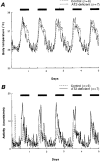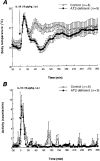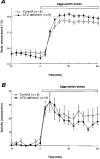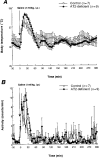Effects of targeted disruption of the mouse angiotensin II type 2 receptor gene on stress-induced hyperthermia
- PMID: 10066912
- PMCID: PMC2269196
- DOI: 10.1111/j.1469-7793.1999.881ab.x
Effects of targeted disruption of the mouse angiotensin II type 2 receptor gene on stress-induced hyperthermia
Abstract
1. We have previously reported that brain angiotensin II type 2 receptors (AT2) contribute to immunological stress-induced hyperthermia (fever) in rats. Now, in mice, we report the effect of AT2 gene disruption on the hyperthermia induced by immunological (interleukin-1 (IL-1) injection) and non-immunological (saline injection or cage switch) stress. 2. AT2-deficient and control mice both showed typical circadian rhythmicity in body temperature and physical activity. During the latter half of the dark period, AT2-deficient mice exhibited a lower body temperature than the controls. 3. By comparison with the controls, AT2-deficient mice exhibited: (i) a significantly smaller hyperthermia after intraperitoneal (i.p.) injection of IL-1beta; (ii) significantly greater increases in body temperature and physical activity after i. p. saline; and (iii) a significantly greater hyperthermia (but a similar increase in activity) during cage-switch stress. 4. These results suggest that AT2, presumably in the brain, plays important roles in stress-induced hyperthermia in mice.
Figures




References
-
- Aguilera G, Kiss A, Luo X, Akbasak BS. The renin angiotensin system and the stress response. Annals of the New York Academy of Sciences. 1995;771:173–86. - PubMed
-
- Cierco M, Israel A. Role of angiotensin AT1 receptor in the cardiovascular response to footshock. European Journal of Pharmacology. 1994;251:103–106. - PubMed
-
- Gelband CH, Sumners C, Lu D, Raizada MK. Angiotensin receptors and norepinephrine neuromodulation: implications of functional coupling. Regulatory Peptides. 1998;73:141–147. 10.1016/S0167-0115(97)11050-3. - DOI - PubMed
-
- Gelband CH, Zhu M, Lu D, Reagan LP, Fluharty SJ, Posner P, Raizada MK, Sumners C. Functional interactions between neuronal AT1 and AT2 receptors. Endocrinology. 1997;138:2195–2198. 10.1210/en.138.5.2195. - DOI - PubMed
-
- Hein L, Barsh GS, Pratt RE, Dzau VJ, Kobilka BK. Behavioural and cardiovascular effects of disrupting the angiotensin II type-2 receptor gene in mice. Nature. 1995;377:744–747. 10.1038/377744a0. - DOI - PubMed
Publication types
MeSH terms
Substances
LinkOut - more resources
Full Text Sources
Medical
Molecular Biology Databases

